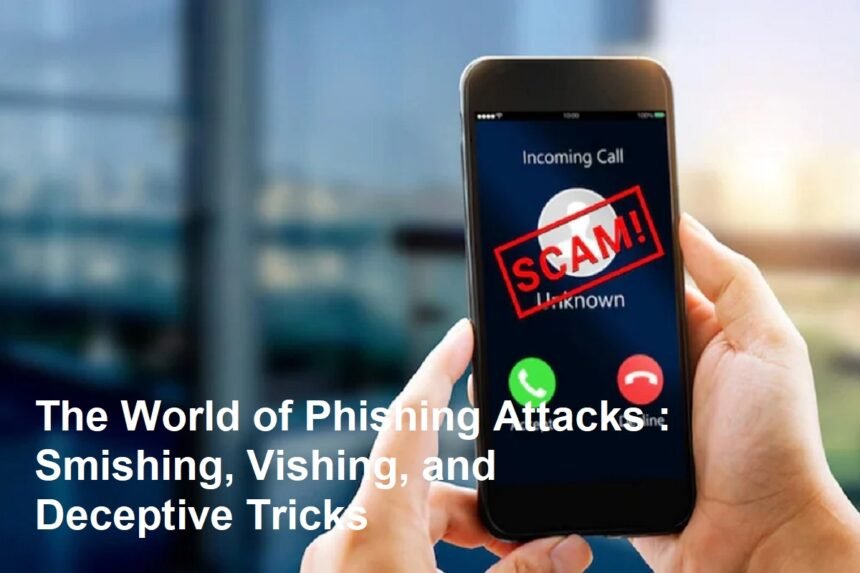Introduction
In the digital age, cybersecurity threats have become increasingly sophisticated, with phishing attacks emerging as one of the most common and dangerous methods used by cybercriminals. These attacks prey on users’ trust and ignorance to steal sensitive information, money, or access to vital systems. To effectively safeguard yourself, it’s crucial to understand what phishing entails and the various forms it can take, including deceptive phishing, smishing, vishing, and the modes these attacks operate through.
What is Phishing?
At its core, phishing is a malicious technique used by cybercriminals to deceive individuals into revealing confidential information. Typically, attackers disguise themselves as trustworthy entities—such as banks, social media platforms, or government agencies—and communicate through emails, messages, or calls to lure victims.
Deceptive Phishing
Deceptive phishing is the classic form of phishing where attackers craft convincing emails or websites that mimic legitimate organizations. These messages often create a sense of urgency or fear, prompting recipients to click malicious links or download infected attachments. Once victims fall for the trap, attackers can access personal data, login credentials, or financial information.
For example, a deceptive email might appear to come from a bank, warning about suspicious activity and urging the recipient to log in via a provided link. However, the link directs to a fake website designed to steal login details. The key characteristic of deceptive phishing is its reliance on visual and contextual deception to appear authentic.
Smishing (SMS Phishing)
Smishing, a portmanteau of “SMS” and “phishing,” involves sending deceptive text messages to individuals’ mobile phones. These messages often appear as official notifications from banks, delivery services, or government agencies, urging recipients to click on links, call phone numbers, or provide personal information.
For instance, a smishing message might claim that the recipient has a pending parcel delivery and instruct them to provide payment details or verify their identity through a malicious link. Because many users trust text messages more than emails, smishing has gained popularity among cybercriminals.
Vishing (Voice Phishing)
Vishing, combining “voice” and “phishing,” involves attackers making phone calls pretending to be representatives of legitimate organizations. The goal is to manipulate victims into revealing sensitive data over the phone.
A typical vishing scam might involve an attacker claiming to be from a bank’s fraud department, requesting verification of account details, or an official government agent demanding immediate action to avoid legal trouble. Vishing relies heavily on social engineering, with scammers often using urgency and authority to pressure victims into compliance.
Modes and Tactics of Phishing
Phishing attacks operate through various modes, each exploiting different communication channels:
- Email Phishing: The most common form, involving fraudulent emails that mimic legitimate organizations.
- SMS (Smishing): As described, malicious texts sent via mobile messaging platforms.
- Phone Calls (Vishing): Deceptive voices attempting to extract sensitive data.
- Social Media Phishing: Fake profiles or messages on social media platforms to lure victims.
- Fake Websites: Cloning legitimate websites to deceive users into entering their login or personal information.
Attackers often employ tactics such as creating convincing fake websites, using personalized information (“spear phishing”), or combining multiple modes to increase their chances of success.
How to Protect Yourself
Awareness and vigilance are key defenses against phishing:
- Always verify the sender’s details before clicking links or providing information.
- Beware of unsolicited messages that create a sense of urgency.
- Use two-factor authentication wherever possible.
- Keep your systems and software updated.
- Install reliable security software and enable email filters.
- Educate yourself about the common signs of phishing attempts.
Conclusion
Deceptive phishing—including smishing and vishing—remains a pervasive threat in the digital landscape. Recognizing the different modes and tactics used by cybercriminals is essential to protect yourself and your organization. Staying vigilant, verifying sources, and practicing safe online habits can significantly reduce the risk of falling victim to these malicious schemes. Remember, in cybersecurity, awareness is your best defense.












